I have received an email from the British Beekeepers Association which yet again stirs the pot about the issue of what's in our food. This one reads more like a scene from a Star Wars movie complete with dastardly crooks, lasers and battles between good and bad. Apparently, fake honey is making its way into markets in North America and Europe.
Given the abyssmal honey crop last year, perhaps fake honey is all there is to buy. Nevertheless, like the horsemeat in ready-made foods scandal, we are again presented with a problem of not knowing what is in our food. Fake honey apparently does contain real honey, just not very much of it. It is bulked up with sugar, malt sweeteners, corn or rice syrup, jaggery (a type of unrefined sugar) and other additives in a process called honey laundering. It is then passed off as real honey.
But coming to the rescue is science in the form of space age lasers designed for missions to Mars. The laser beams in question can be fired at tiny amounts of honey and the resulting burn-off can be analysed. This can be used to work out the contents of fake honey and even the origin of real honey.
The question is, why would criminals bother? The answer is that food fraud is profitable. As with the horsemeat scandal, cheaper materials can be passed off as something of a much higher value. And let's face it, honey is not cheap. Indeed, after last year's crop failure, it is rather more expensive than usual.
Long supply chains stretching half way around the planet are an ideal target for food fraudsters. We have seen that with the horsemeat scandal. The solution, and sorry to keep banging on about this, is buy as locally as possible from sources you can trust.
If you want to read the full article on the Arstechnia site go to: http://arstechnica.com/science/2013/02/laser-intended-for-mars-used-to-detect-honey-laundering/.
We grow our own food in a suburban village in the North East of England. Follow us as we keep up the battle to be self-sufficient.
Thursday 28 February 2013
Is this the first hint of spring?
I spent a few hours on the allotment yesterday in the sun. For the second time in just over a week, it was warm enough for the bees to be active. Indeed, the hives were very busy. When the bees first got active a couple of weekends ago, I was a bit concerned that there was nothing for which they could forage. They could end up burning lots of energy for little return. Yesterday I saw some bringing in pollen. It seems they have found some flowers after all.
With the daffodils starting to grow, the bees getting busy and blue sky and sun, are be getting the first hints of spring?
With the daffodils starting to grow, the bees getting busy and blue sky and sun, are be getting the first hints of spring?
Self-Sufficient in Suburbia - Autumn 2012
This is a bit late but the video covers the second half of autumn, as we approach the end of the wettest year year on record. I show you the damage caused by the flooding from the heavy rain. Then ducks have started laying so I try my hand, not entirely successfully, at using the eggs to bake a sponge cake. Our Tamworth pig has been slaughtered so we roast one of the leg joints. Meanwhile, the remaining autumn crops are turned into preserves.
Monday 25 February 2013
Sausage meatloaf

I made this on Friday last week. It is a meatloaf made from sausagemeat from our Tamworth pig. I added a couple of handfuls of breadcrumbs, half an onion chopped, 5 small apples grated, a couple of crushed cloves of garlic and a smattering of cayenne pepper. I roasted it at 190C for half an hour. I am using it for lunches this week.
Sunday 24 February 2013
How to make pork burgers
Forget about all those horsemeat burgers on sale in the supermarkets! Here's how I make pork burgers.
Roast lamb
Last month we swapped some of our pork for a friend's lamb. We roasted one of the leg joints recently. The video shows the results.
Boosting our fat supply - wartime style
One of my criticisms of the modern diet is that it contains too much fat. Processed foods and ready-made meals seem to be stuffed full of it. Fat is an essential part of the diet, but too much of it and too little exercise is a dangerous combination. For us, the problem is the opposite. Finding our own source of fat has been quite a challenge so we turned to history for the answer.
During the Second World War, and in the immediate postwar years, fats were tightly rationed but the wartime Ministry of Food produced helpful leaflets that explained how to make the most of your rations and eat a healthy diet. One of the leaflets explained how to render fat from meat. We used this leaflet to extract the fat from joints from our Tamworth pig.
Pork was is short supply during the war years as pig production was low priority for the wartime government. Thousands of pig clubs were set up however in which people could together buy a piglet and raise it for slaughter. The pigs would be fed on kitchen waste (no longer permitted here in the UK), garden waste, foraged wild food and pig swill from the local council if the latter collected food waste separately. Typically, a council supplying swill would be able to claim a share of the slaughtered pig for use in local community restaurants called British Restaurants.
These pig clubs provided their members with pork and bacon over and above the basic meat and bacon rations. But they also provided their members with the opportunity to boost their fat supply.
The past has much to teach us. Looking around at people's diets these days, and the near criminal waste of food, I wonder just how many people need to relearn the lessons from history.
How to make beetroot relish
I filmed this late last year but I've only just got round to editing the material on that tape recently. So here is the recipe I used to turn part of last year's beetroot crop into a relish.
Friday 22 February 2013
Making burgers
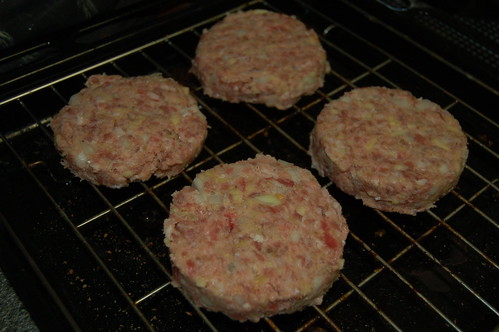
Whilst the country is gripped by the horsemeat in food scandal, back at our house, we do not suffer from that problem. We rarely buy ready made meals or industrial preprocessed food. Burgers were the first food to be found to contain horsemeat. I have to confess we eat very few burgers but last night we decided it was time to use some of our Tamworth sausage meat to make some.
I added some breadcrumbs, garlic, onion, apple and cayenne pepper to the sausage meat.
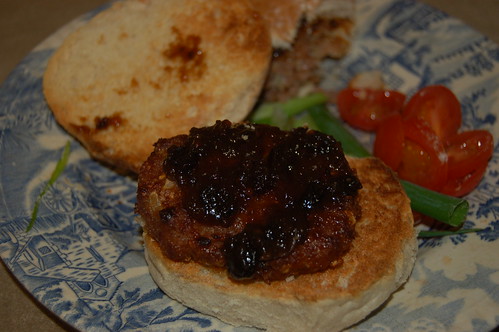
The above was the result. Grilled and then into a bun with a dollop of pumpkin chutney on top. We'll be making more at some point in the (hopefully) not too distant future.
Belly pork roasted
We had roasted belly pork on Monday evening. I rubbed garlic, thyme, fennel seeds, pepper corns and olive oil into the skin. A wonderful meal.
Tuesday 19 February 2013
The wanderer returns
Last night we had a missing hen. It was one of the new rhode rocks. We closed up the henhouses as usual but instead of 17 hens in them, there were only 16. I shone the torch into the neighbouring hedgerows. Last year a few of our new hens tried to roost for the night in hawthorn bushes. Yet there was no sign of her and a quick check of the allotment produced nothing. Back on the allotment this morning and no sign of her when I arived. And then she appeared. I have no idea where she spent the night. There are foxes in the area though they stay away from the allotment in daylight. That means any hen taking a midnight jaunt around the patch is vulnerable. Fortunately, luck was on her side. And tonight, thankfully, she decided to tuck herself up in one of the henhouses.
Shed building
Over the weekend we addressed our acute shortage of storage space by building a shed on the allotment. We should have sorted this years ago as the shortage of space has held us back. Not any more (hopefully!)
Monday 18 February 2013
Creating storage space
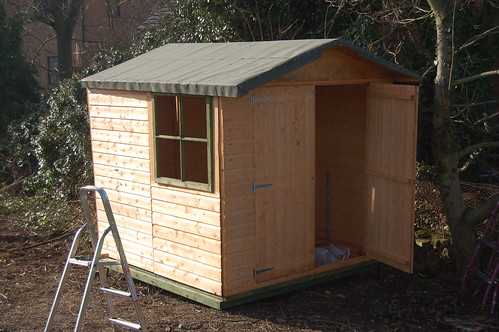
If you are setting out to be self-sufficient, sorting out your storage space should be an early task to be tackled. We learnt this the hard way. We relied on our garage which ended up being filled with equipment and stores of food. On the allotment we ended up treating the greenhouse as a storage space. In other words we should have sorted out having a shed some time ago. Instead, we built it over the weekend. The picture above is of the shed before the finishing touches and the wood preserver went on. Below, the photos show it completed.
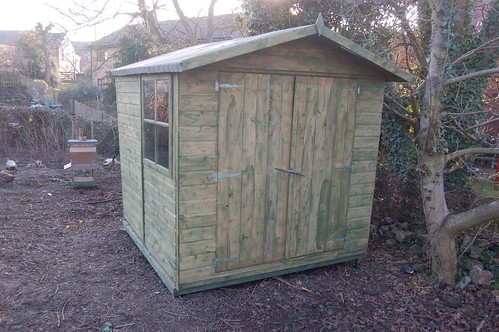

We need to add guttering and water butts to it. We have no mains water supply on the allotment. Nor do we want tap water. It is a total waste to pour it on the ground when we can be using rainwater which falls naturally on the allotment. Mains water needs resources to capture and store it, clean it and pump it to our homes. We all need to cut down on its use, even in a year like 2012 when the reservoirs were filled to overflowing by excessive rain.
Sunday 17 February 2013
How to make runner bean chutney
I filmed this late last year but my video editing is a bit behind schedule. We had a good crop of runner beans (lots of other crops failed!) so as well as salting and freezing them, we turned some into chutney.
Shed building in the sun
Today was scheduled for one job, though a major one for us. The shed we bought last month needed to be built. We were helped by the weather. The day felt more like spring. Sunny and warm temperature also brough out our bees for the first time this year. The hens lent a helping hand (wing?) by invading the shed as we built it. They will take an interest in anything that is new. They also took an interest in my lunch box. I shouldn't have left off the lid. One hen stole one of my jam tarts and then got mobbed by the other hens. The jam tart itself was gone in seconds. I had better make some more (for our consumption, not for the hens!)
The shed is now built though there are a few jobs to do: glass into the windows, felt onto the roof and preservative painted onto it. These will be done on Sunday.
The shed is now built though there are a few jobs to do: glass into the windows, felt onto the roof and preservative painted onto it. These will be done on Sunday.
Thursday 14 February 2013
Speaking on the BBC
I had a phone call from BBC Radio Mersey today asking me to do an interview on their drive time show about what people ate during the years of wartime rationing. They had picked up on the work I did in 2011 on the wartime diet. What kicked off their interest was the on-going saga of horsemeat in various beef products. So I agreed to do the interview and shortly before 5pm they phoned me back. The interview went out live. The interviewer was especially keen to ask about mock foods. He also made a reference to the BBC tv series, The Wartime Farm - I reviewed the book of the series last year. He finished by asking if I would be doing any more wartime cooking - to which the answer is definitely yes. We are also going to run my Dad's allotment as it would have been in the war years. Watch this space for more news on how we get on.
Anyway, here's the link to theinterview. I am on just over 56 minutes intot he programme: http://www.bbc.co.uk/programmes/p0147vrj
Anyway, here's the link to theinterview. I am on just over 56 minutes intot he programme: http://www.bbc.co.uk/programmes/p0147vrj
Three duck eggs today
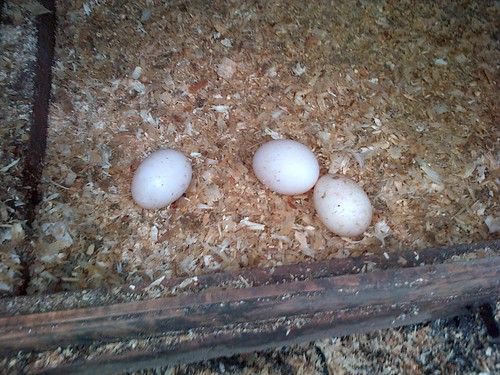
It seems our ducks are getting into the swing of laying. When I opened the duck house this morning, there were three eggs in there, waiting to be collected. We have only once before collected three eggs in a single day, and I am convinced that, on that occasion, one of them had been laid the previous day. So, 3 of the five ducks are laying - and hopefully they will be doing so on a regular basis. Meanwhile, the 2 drakes are getting a bit randy, chasing the ducks about and doing their thing without a moment's modesty!
One of the eggs this morning had a crack in it so it will be used later today to make pancakes.
Using leftovers - making a shepherd's pie
We used half the meat on the lamb leg joint we had in our Sunday dinner. I then removed the leftovers from the bone and these were then put through our mincer.
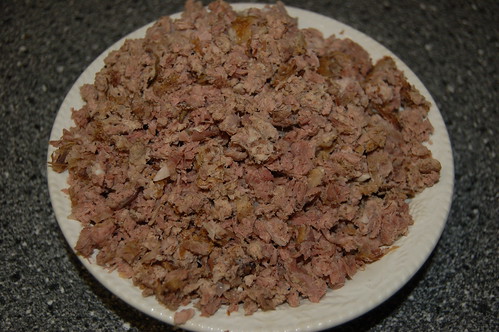
The mince was then used to make a shepherd's pie. This is the real deal, nothing like the mass-produced, ready-made meals on sale in the giant supermarkets. And of course, it contains real lamb (the traditional ingredient of a shepherd's pie) not horsemeat. We still have a few cabbages on the allotment so one of them was used with the shepherd's pie.
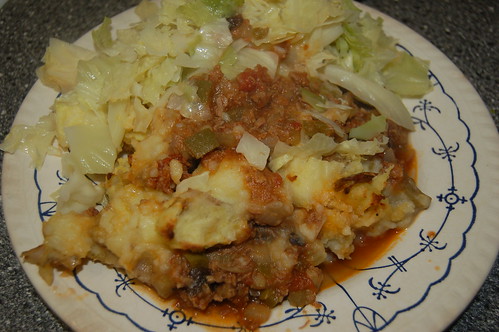
The leg bone from the joint has not been wasted. It was boiled up this afternoon to make stock which I will use tomorrow to make tomato soup - I have some pulped tomotes in the freezer which started out life on a neighbouring allotment. We swapped eggs for them.
And just to make sure nothing is wasted, the bone, now that it has been used to make stock, will be roasted a number of times in the oven and then ground down to make bonemeal.

The mince was then used to make a shepherd's pie. This is the real deal, nothing like the mass-produced, ready-made meals on sale in the giant supermarkets. And of course, it contains real lamb (the traditional ingredient of a shepherd's pie) not horsemeat. We still have a few cabbages on the allotment so one of them was used with the shepherd's pie.

The leg bone from the joint has not been wasted. It was boiled up this afternoon to make stock which I will use tomorrow to make tomato soup - I have some pulped tomotes in the freezer which started out life on a neighbouring allotment. We swapped eggs for them.
And just to make sure nothing is wasted, the bone, now that it has been used to make stock, will be roasted a number of times in the oven and then ground down to make bonemeal.
Wednesday 13 February 2013
Ducking the issue
We got our ducks in early September last year and in October, one of them started laying. She turned out to be very productive, producing an egg nearly every day. By late October, a second had started laying. For two days in a row in November, two eggs were laid. But then the 2nd duck stopped producing eggs other than an occasional one. Why she went on a go slow, we don't know. The good news now is that for the past three days, we have had two eggs a day and I'm hoping this is a sign that either the second duck, or one of the ducklings that has gone past point-of-lay, has gone into full production.
Meanwhile, production from our hens has gone up. We have, over the past week, been getting on average 12 a day. Two months ago, the average was down to 6 a day. Progress at last!
Meanwhile, production from our hens has gone up. We have, over the past week, been getting on average 12 a day. Two months ago, the average was down to 6 a day. Progress at last!
To trust the food you eat, make it yourself
As I write this, I see another horsemeat in food scandal is breaking. Two UK abattoirs had been raided by the police following concners raised by the Food Standards Agency and there are stories about horsemeat being passed off as beef. It reflects the other news stories of recent weeks about horsemeat in burgers, lasagne and so on. My first response on hearing about this issue was to express some degree of amazement that there was any significant amount of any meat in value burgers. My next response was to be surprised at people's horror at the idea of eating horse. Horsemeat is as healthy as beef and is eaten widely in Europe and elsewhere. It used to be eaten widely in Britain. After the Second World War, when the UK was still experiencing severe food rationing, horsemeat was eaten and people welcomed the opportunity to consume it. Since then it has largely fallen off the menu of the British, or so we all thought, until we discovered that many processed foods and ready made meals were found to contain it.
This is a fraud, not a health, issue. The question is, can you trust the label on the foods for sale in the supermarkets? I don't know whether there is a straightforward yes or no to that. However, if you definitely want to trust the meals you eat, make them yourself! And if you can grow the ingredients yourself, even better.
Our food supply system has become too much like the banking system: it is a vital part of the economy but it is dominated by too few producers and too few retailers. A few abattoirs or retail companies supply food that is too easily contaminated and is then sold in thousands of shops across not just Britain but Europe and beyond. One screw up and thousands, possibly millions of people are affected.
But we can't just blame the producers and retailers. Society has to accept some level of responsibility. Cheap food that can be consumed to excess or dumped as waste has come at an enormous price to society in terms of health and the environment. It may be great to have cheap food now but we end up paying more in the future to treat obesity or deal with the damage caused to the environment by over producing or disposing of excessive packaging or food waste.
So, as the horsemeat scandal ripples out through the food supply system, I wonder what those who sneer at my self-sufficiency lifestyle have to say as they chomp their way through their horse burgers or their equine lasagne.
This is a fraud, not a health, issue. The question is, can you trust the label on the foods for sale in the supermarkets? I don't know whether there is a straightforward yes or no to that. However, if you definitely want to trust the meals you eat, make them yourself! And if you can grow the ingredients yourself, even better.
Our food supply system has become too much like the banking system: it is a vital part of the economy but it is dominated by too few producers and too few retailers. A few abattoirs or retail companies supply food that is too easily contaminated and is then sold in thousands of shops across not just Britain but Europe and beyond. One screw up and thousands, possibly millions of people are affected.
But we can't just blame the producers and retailers. Society has to accept some level of responsibility. Cheap food that can be consumed to excess or dumped as waste has come at an enormous price to society in terms of health and the environment. It may be great to have cheap food now but we end up paying more in the future to treat obesity or deal with the damage caused to the environment by over producing or disposing of excessive packaging or food waste.
So, as the horsemeat scandal ripples out through the food supply system, I wonder what those who sneer at my self-sufficiency lifestyle have to say as they chomp their way through their horse burgers or their equine lasagne.
Sunday 10 February 2013
Roast lamb
We decided it was time to use some of the lamb we got last month - we swapped it for some of our pork with a friend who had just had her lambs slaughtered. So one of the leg joints came out of the freezer last night.. This evening we pierced the skin of the lamb with garlic and rosemary, both from our garden, and then seasoned it. The joint was roasted for half an hour for each 450g.

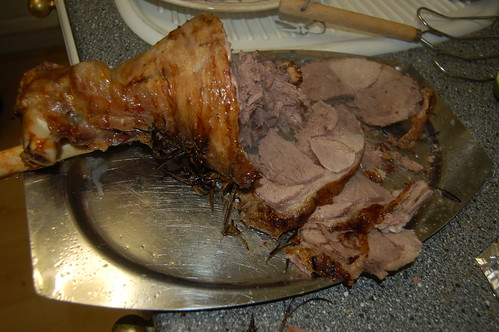
We also had artichoke puree with cream and egg (which helped to bind it together). We have lots of artichokes on the allotment. We discovered last year that it is better to dig them up and use them as they are needed. Last year we dug up the whole crop, stored it and them found the artichokes shrivelling up after just a couple of weeks.
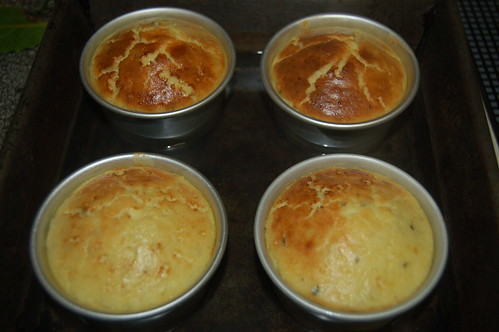
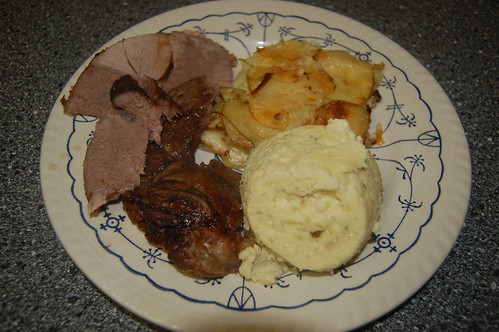
The final veg was potatoes in cream and herbs. Missing from the above photo is rosemary jelly I made recently, and, of course, the gravy, made from the meat juices.
And the final verdict? An excellent meal! The leftover lamb will be used to make a shepherd's pie later this week.


We also had artichoke puree with cream and egg (which helped to bind it together). We have lots of artichokes on the allotment. We discovered last year that it is better to dig them up and use them as they are needed. Last year we dug up the whole crop, stored it and them found the artichokes shrivelling up after just a couple of weeks.


The final veg was potatoes in cream and herbs. Missing from the above photo is rosemary jelly I made recently, and, of course, the gravy, made from the meat juices.
And the final verdict? An excellent meal! The leftover lamb will be used to make a shepherd's pie later this week.
Recent preserves
It's amazing what you find in the freezer. We did a check of the contents of ours and found a load of fruit. So out it all came and I made various different preserves.
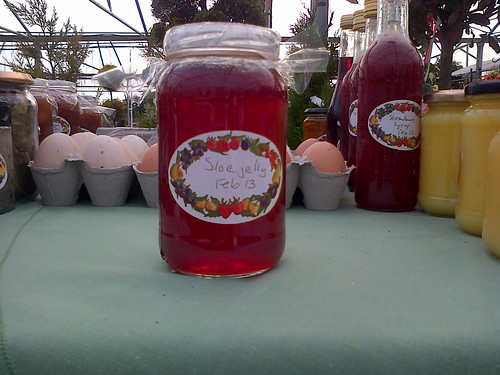
Sloe jelly: the sloes were definitely not from last year. There was no sloe crop in our area in 2012 so the bag of sloes I found must have come from 2011. The apple crop failed last year so the apples I used to set the jelly came from our local fruit shop. They were selling off bags of apples for 50p. They were slightly misshapen. That's enough to make them very difficult to sell in this age when so much food is wasted if it doesn't look quite right.
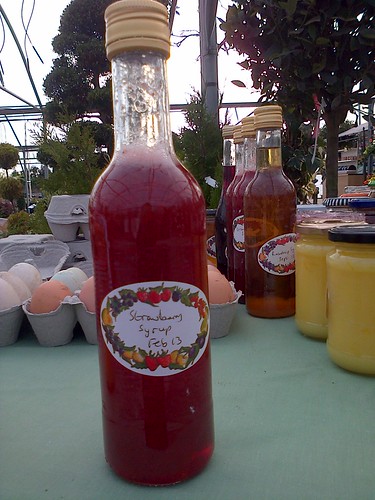
Strawberry syrup: I had a stock of strawberry puree in the freezer which I had planned to use to make ice cream. Instead, I decided to make it into a syrup. It will be used on Tuesday, pancake day, to be sprinkled on our pancakes.
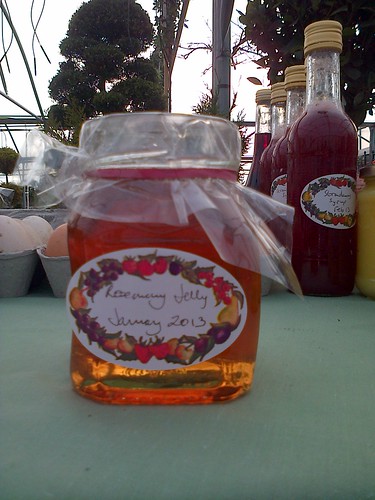
Rosemary jelly: this was made using fresh rosemary from the garden and some frozen apple. We've just tested it out on a roast leg of lamb (the lamb we swapped for some of our Tamworth pork last month).
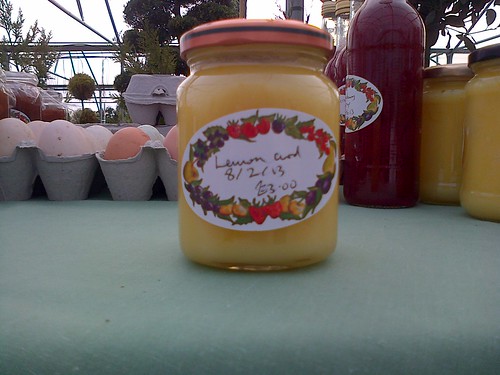
Lemon curd: very nice! It's not made from the contents of the freezer but we were able to use up some of our eggs. The by-product is lemon marmalade, made from the leftover lemon skins. The marmalade is not yet made. The skins have gone into the freezer to occupy the space created by using the sloes, apples and strawberry puree.

Sloe jelly: the sloes were definitely not from last year. There was no sloe crop in our area in 2012 so the bag of sloes I found must have come from 2011. The apple crop failed last year so the apples I used to set the jelly came from our local fruit shop. They were selling off bags of apples for 50p. They were slightly misshapen. That's enough to make them very difficult to sell in this age when so much food is wasted if it doesn't look quite right.

Strawberry syrup: I had a stock of strawberry puree in the freezer which I had planned to use to make ice cream. Instead, I decided to make it into a syrup. It will be used on Tuesday, pancake day, to be sprinkled on our pancakes.

Rosemary jelly: this was made using fresh rosemary from the garden and some frozen apple. We've just tested it out on a roast leg of lamb (the lamb we swapped for some of our Tamworth pork last month).

Lemon curd: very nice! It's not made from the contents of the freezer but we were able to use up some of our eggs. The by-product is lemon marmalade, made from the leftover lemon skins. The marmalade is not yet made. The skins have gone into the freezer to occupy the space created by using the sloes, apples and strawberry puree.
Thursday 7 February 2013
Discoveries in the freezer
A good piece of advice: do an occasional check on the contents of the freezer. It's interesting what you find. I did a sort through yesterday and found bags of sloes, raspberries, rhubarb, gooseberries, lemon skins and apple. As a result, I've now made 14 jars of rhubarb, gooseberry and apple jam and 7 of raspberry and apple. Simmering away in my preserving pan at the moment are apple cores and peel, sloes and lemon. They are on their way to being sloe jelly. Meanwhile, the nettle flan I took out of the freezer will be used for dinner tomorrow evening. Tonight we are having bacon butties, to use up a bit more of our Tamworth pig.
Tuesday 5 February 2013
Our daily bread
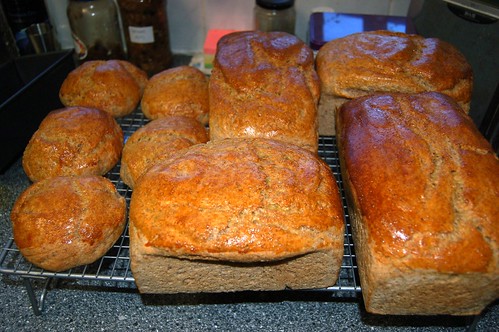
Just finished making the bread for the week. Four loaves and 5 rolls, made using equal quantities of rye and plain flour and glazed with egg. We now have room in the freezer for them as I discovered today some frozen fruit and rhubarb from some time ago. It's thawing in the kitchen and will be used for jam making later this week.
Bangers and mash
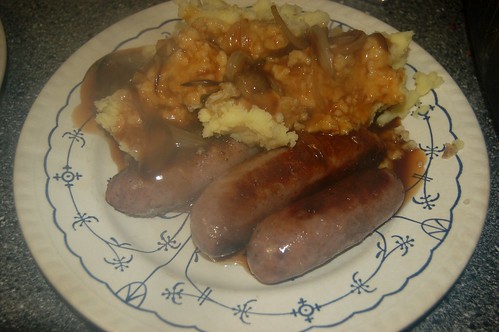
We haven't used many of the sausages we got from our Tamworth pig so last night we made a concerted attempt to eat more of them, especially now that I have my sausage making machine and a supply of lamb to put through it. So bangers and mash were on the menu for dinner last night. And very nice indeed they were!
Saturday 2 February 2013
On dry land
We all know that here in England, we had our wettest year on record in 2012. The rain continued right up to the end of the year and then, at least where we are in the North East, the intensity of rainfall fell considerably. That's not to say we have had no rain. We have had some, but it is closer to what we would normally expect. There was, of course, the snow. It lay for two weeks in our part of the world but has now thawed and gone.
My fear was that once the snow had melted, the allotment would turn to the Somme style landscape of mud and puddles. Last year, there was so much rain that the ground was saturated. It could take no more rainwater so everytime it rained, the water simply sat on the surface. Once the hens, ducks and ourselves had tramped through it a few times, mud was everywhere. Interestingly, this has not happened this time round.
Instead, the puddles and mud have been largely absent. Okay, some of the ground is wet, the ground around the duck house and the fruit cage was very wet and a stream ran for a few days across the allotment, but the chaos I expected never happened. So why is that? Well, the more normal levels of rainfall has, I reckon, given the ground the chance to drain. The first 2 weeks of January saw only modest rain and during the second two weeks, the surface of the ground was frozen. The freeze, however, did not penetrate the ground to a significant depth. There is a depression in the ground where our allotment gate opens and I noticed that when everything else was frozen, that patch was wet. So, go down into the ground a few centimetres and the deep freeze didn't penetrate. So, for nearly a month, the ground had a chance to drain off some of the excess from last year.
We will however still be putting in drainage this year. We do not want to get caught out as we were last year by the weather. It will be the biggest single project of the year but it has to be done.
My fear was that once the snow had melted, the allotment would turn to the Somme style landscape of mud and puddles. Last year, there was so much rain that the ground was saturated. It could take no more rainwater so everytime it rained, the water simply sat on the surface. Once the hens, ducks and ourselves had tramped through it a few times, mud was everywhere. Interestingly, this has not happened this time round.
Instead, the puddles and mud have been largely absent. Okay, some of the ground is wet, the ground around the duck house and the fruit cage was very wet and a stream ran for a few days across the allotment, but the chaos I expected never happened. So why is that? Well, the more normal levels of rainfall has, I reckon, given the ground the chance to drain. The first 2 weeks of January saw only modest rain and during the second two weeks, the surface of the ground was frozen. The freeze, however, did not penetrate the ground to a significant depth. There is a depression in the ground where our allotment gate opens and I noticed that when everything else was frozen, that patch was wet. So, go down into the ground a few centimetres and the deep freeze didn't penetrate. So, for nearly a month, the ground had a chance to drain off some of the excess from last year.
We will however still be putting in drainage this year. We do not want to get caught out as we were last year by the weather. It will be the biggest single project of the year but it has to be done.
Subscribe to:
Posts (Atom)